Zoom
Trash

(2) Thoth's Master-plan of Secret Teaching - Hermetic Tablets Recovered Info. Egyptian Myths and Mysteries 1908. Egyptian Myths and Mysteries 1908, a cycle of 12 lectures by Rudolf Steiner, given in Leipzig from September 2 - 14, 1908.
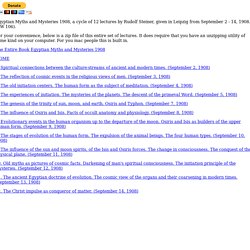
(CW 106). For your convenience, below is a zip file of this entire set of lectures. It does require that you have an unzipping utility of some kind on your computer. For you mac people this is built in. The Entire Book Egyptian Myths and Mysteries 1908 1. 2. 3. 4. 5. The Emerald Tablets of Thoth, Female Voice, Audio Book. The Story of Osiris. WHAT ARE THE WANDS OF HORUS? Pick up any book about Ancient Egyptian culture and take a close look at the statues of the pharaohs: you will see that they are all clasping cylinder-like objects in their hands.
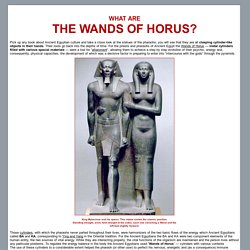
Their roots go back into the depths of time. For the priests and pharaohs of Ancient Egypt the Wands of Horus — metal cylinders filled with various special materials — were a tool for “attainment”, allowing them to achieve a step by step evolution of their psychic, energy and, consequently, physical capacities, the development of which was a decisive factor in preparing to enter into “intercourse with the gods” through the pyramids. King Mykerinus and his queen. This statue shows the classic position. Standing straight, arms held straight at the sides, each one clenching a Wand and the left foot slightly forward. EGYPT BEFORE THE PHARAOHS. Fortunately the Palermo stele also cites these so-called "mythical" pre-dynastic kings going back thousands of years.
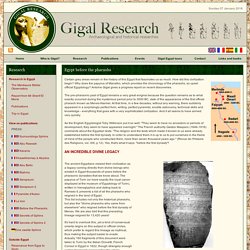
It refers to Horus himself as having reigned over the land of Egypt. According to Manetho, Thoth reigned approximately from 8670 to 7100 BC, "after the night of the battle". Hesiod, the renowned historian and moralist living at the time of Homer (8thC BC), obtained most of the information he recorded in his Theogamy, a genealogy of the dynasties known as celestial that reigned on Earth, from the Egyptian high priests. The Egyptian High Priest Manetho (Ma-n-Thoth) from Sebennytos in the Delta, Master of the Secrets (3rdC BC), who had access to the library of Alexandria and who wrote for the pharaoh a history of Egypt in Greek in 30 volumes, the Aegiptiaca, also cited these pre-dynastic dynasties of divine origin. Manetho gives us very interesting details on the dynasties called "divine", which he divides into three categories: Gods, Heroes, and "Manes".
Ogdoad. In Egyptian mythology, the Ogdoad (Greek "ογδοάς", the eightfold) were eight deities worshipped in Hermopolis during what is called the Old Kingdom, the third through sixth dynasties, dated between 2686 to 2134 BC.
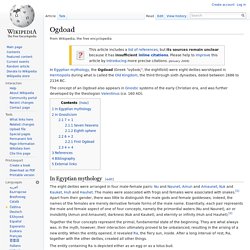
In Egyptian mythology[edit] Together the four concepts represent the primal, fundamental state of the beginning. 114 Gods of Ancient Egypt, Ägyptische Götter. Ogdoad. Ogdoad In Egyptian mythology, the Ogdoad are the eight deities worshipped in Hermopolis.
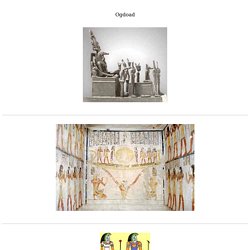
The gods of the Ogdoad were mostly seen as humans with their animals' heads, or just depicted as snakes and frogs. They were arranged in four male-female pairs, with the males associated with frogs, and the females with snakes. [Frogs are assciated with biogenetic experiments. Snakes represent human DNA.] The Sungod's Journey Through the Netherworld. "The ancient Egyptian sources come alive, speaking to us without seeming alien to our modern ways of thinking.

Andreas Schweizer invites us to join the nocturnal voyage of the solar barque and to immerse ourselves, with the 'Great Soul' of the sun, into the darkness surrounding us. Here in the illustrations and texts of the Amduat, threats hidden in the depths of our soul become visible as concrete images, an analysis of which remains ever worthwhile: even in the guise of the evil, ominous, or dark side of godhead with which Schweizer concerns himself. The netherworld into which we descend underlies our own world. Creative energies of dreadful intensity are active there, and only death, to which all must surrender, makes us truly alive by offering us regeneration from the depths. " Karnak: Temple Complex of Ancient Egypt-Statues of Ramses II as Osiris in Karnak Temple. Karnak: Temple Complex of Ancient Egypt with of Statues of Ramses II as Osiris in Karnak Temple.
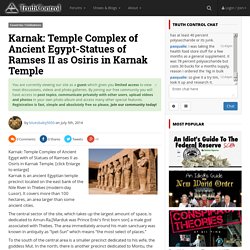
[click Enlarge to enlarge] Karnak is an ancient Egyptian temple precinct located on the east bank of the Nile River in Thebes (modern-day Luxor). It covers more than 100 hectares, an area larger than some ancient cities. The central sector of the site, which takes up the largest amount of space, is dedicated to Amun-Ra,[Marduk was Prince Enki's first born son] a male god associated with Thebes. The area immediately around his main sanctuary was known in antiquity as “Ipet-Sun” which means “the most select of places.” Gerald Massey. Excerpts From "Ancient Egypt, Light Of The World" By Gerald Massey.
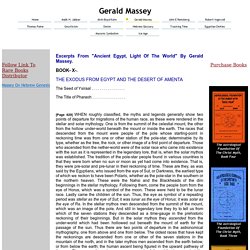
The Seed of Ysiraal . . . . . . . . . . . . . . . . . Lost Cave City in the Grand Canyon? Lost Cave City in the Grand Canyon?
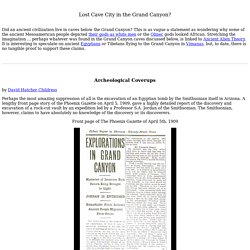
Did an ancient civilization live in caves below the Grand Canyon? This is as vague a statement as wondering why some of the ancient Mesoamerican people depicted their gods as white men or the Olmec gods looked African. Osiris - Egyptian Mythology for Smart People. Osiris was the ruler of the Egyptian underworld (Duat) and a god of death and immortality, amongst other things.

God of Death and Immortality. Revealing Ancient Egyptian Mystery Teachings. Osiris Myth - Video Documentary. For thousands of years Giza's Great Pyramids have stood, keepers of ancient secrets, harbouring a message that mankind has long forgotten.. Imhotep, Master of Sciences. Imhotep – Maybe no other civilization of the antiquity is better known, from the point of view of the archeological vestiges, than the civilization of ancient Egypt. With all these, paradoxically, no other ancient civilization is less understood and, so, more mysterious than the Egyptian one. In all Egyptology treaties figures the name of a character, who wasn’t a conqueror or a pharaoh, but an artist and savant.
This one is Imhotep, doctor, architect and the main chancellor of king Zoser (approx. 3150 BC). The Egyptologists say that Imhotep was born at Memphis (ancient Egyptian city) but, thanks to his wisdom he did so much for the Egyptian medicine that he was in time, adored as the god of knowledge and worshiped as the founder of sciences and arts. The Mystery of Abydos and the Osirion Temple. ANCIENT STRUCTURES - Abydos is one of the most ancient cities of Upper Egypt. In ancient times it was called Abdu, "the hill of the symbol or reliquary," in which the sacred head of Osiris was preserved. The Greeks called it Abydos. Ancient Egypt. Amen (also Amun) - The hidden one 2500 BCE to present Amen comes from Egypt , as a supreme creator God, worshipped as pre-Dynastic, but officially “emerged”around 2500/2400 BCE to 400CE.
Like much of Ancient Egyptian history, the history of worship and meaning of Amen was lost until recent times. Synonyms include Amen kem-atef (snake god), Amen kamutef (fertility god). Land of Osiris: Things Egyptologists won't say.. Did Ra have an female counterpart in the Egyptian Pantheon? Nut, pronounced Noot. Was the name of RA's Wife, Nut was the God of the Sky and Ra was the Sun God. If you think about the sun being, in the sky it makes sense. When Ra reigned as king of Egypt, Thoth (Djehuty) prophesied that Ra's wife Nut would have a son who would reign as king. Ra cursed Nut and said, "Nut will give birth to no son on any day of any year, nor at night time either. " Ra's curse could not be broken, but Thoth had a clever plan. Apep (Apophis) 2,400-Year-Old Coffin's 'Odd' Art Hints at Ancient Egypt's Brain Drain. TORONTO — An ancient Egyptian coffin with strange and amateurish decorations has been revealed, shedding light on a tumultuous period in Egyptian history when the Persian Empire was in control of the region.
The Lost Gods: The Egyptians. The Descendents of Nun: A Creation Myth From Egypt. King Tut's DNA Results Are Out! Video From 2011. Egyptian Mythology - Myth Encyclopedia - god, story, names, ancient, tree, animal, snake, world, Roman, creation. Bordered by deserts, Egypt's Nile River valley was relatively isolated from other centers of civilization in the ancient Near East for thousands of years. As a result, Egyptian religion remained almost untouched by the beliefs of foreign cultures. The religion included a large and diverse pantheon of gods and goddesses, and around these deities arose a rich mythology that helped explain the world. pantheon all the gods of a particular culture deity god or goddess Conquest by the Macedonian ruler Alexander the Great in 332 B . C . and by the Romans about 300 years later weakened the Egyptian religion. Pyramids were built to honor the powerful kings of Egypt and to give them a home and provisions in the afterlife.
Cults and Deities Religion and religious cults played a central role in all aspects of ancient Egyptian society. Egyptian Mythology Names. Gods and Goddesses. Egyptian mythology. When Gods Walked the Earth Among Humans.